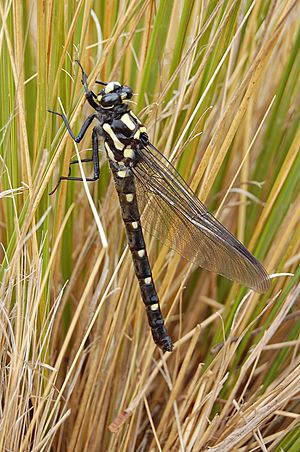New Zealand mountain giant dragonfly facts for kids
Quick facts for kids New Zealand mountain giant dragonfly |
|
|---|---|
 |
|
| Conservation status | |
| Scientific classification |
Uropetala chiltoni is a very large dragonfly found only in New Zealand. It's often called the New Zealand mountain giant dragonfly. The Māori name for these big dragonflies is kapokapowai, which means "water snatcher." This name describes how the young dragonflies, called nymphs, live in water. Like all dragonflies, they have a special long jaw that shoots out to grab their food!
What Does It Look Like?
The mountain giant dragonfly is the second-largest dragonfly in New Zealand. Its body is about 80 mm long, which is about the length of a smartphone. Its wings can spread out to about 100 mm wide, like a small ruler.
You can tell Uropetala chiltoni apart from a similar dragonfly, Uropetala carovei, by a few key features. Uropetala chiltoni has big, pale spots on its upper lip, called the labrum. The Uropetala carovei has an all-black labrum. Also, the upper part of its legs, called the femur, is black. In Uropetala carovei, these leg parts are brownish. Scientists officially described this dragonfly as its own species in 1921.
Where Do They Live?
This special dragonfly lives only in New Zealand. You can find it in the higher, cooler parts of the South Island. People have seen them from places like Lake Rotoiti all the way down to Lake Wakatipu. They also live east in the Old Man Range and Garvie Mountains. There have been some reports of them in the southern North Island, but these haven't been fully confirmed yet.
Life in the Swamp
The young dragonflies, or nymphs, of Uropetala chiltoni are quite interesting. They dig tunnels into the soft, wet ground around mountain swamps or damp areas. These spots are often found in grassy fields with a plant called Schoenus tussock. Even if there are trees nearby, the nymphs prefer to live in wet, open spaces within the forest.
They live in these tunnels, which are about half-filled with water, for a long time—maybe 5 to 6 years! At night, they come out of their burrows to look for food near the entrance. An early scientist named Tillyard noticed that these nymphs are quite calm when you dig them out of their homes. They are not aggressive like the nymphs of U. carovei. Adult dragonflies fly around the edges of forests and swamps, hunting for their prey.
Images for kids



